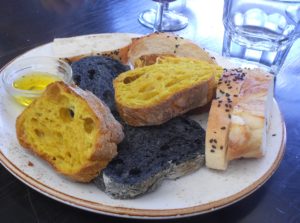
When we would like to give thanks, we celebrate – and celebrations usually include a meal. Most European words relating to food and meals have to do with the staple food for the European and Mediterranean population for many centuries: bread. Not having access to bread meant hunger and most likely famine.
I am thinking of times long before potatoes, rice or pasta were widespread in these areas.
Food is a very important part of our lives. Food sustains us but it also gives us pleasure (if we like it) – and if it is shared with people we like, it is even more tasty. If the food is juicy, it even provides some of the liquid our bodies need.
Food, tastes and smells often remind us of a certain time in our lives or of a certain moment. We re-member, putting things together and re-living the moment.
The Jewish tradition of remembering while sharing food probably started with Exodus 16:32 when the Lord asked Moses to keep some manna so that generations to come will see how God provided for the Israelites. Moses was also given instructions on how and when to eat the manna. For those generations that were not able to see and taste the manna, it is described as looking like coriander and tasting like wafers made with honey. We know coriander, wafers and honey – so we can put these tastes together and re-member.
The Jewish Seder Meal is about remembering the flight out of Egypt. Every component of the meal has a story that is connected to it and through which the Jewish communities have been keeping the exodus story alive through generations.
From the Gospels we know that food was also very important in Jesus’ life. It was not just important because it was necessary for survival, but Jesus used meals to reach out to people.
His ministry began with the Wedding of Cana when his mother asked him to save the bridegroom from embarrassment when the wine ran out. Not only did Jesus help out but the water that was turned into wine was better than the wine that was served before.
When Jesus fed the crowds in John 6, he didn’t just feed them, but his disciples gathered leftovers. Abundance.
Jesus shared meals with people from the margins of his society. He included everyone – much to his disciples’ surprise and sometimes even horror.
God gave instructions for the meals in Exodus, and it certainly became a tradition that one had to first give thanks to God and ask for God’s blessing before starting the meal.
Jesus followed these instructions. In fact, when the loaves and fish were multiplied, the Gospels don’t say that Jesus multiplied the food but rather concentrate on the ritual of giving thanks and blessing the food.
Jesus gives himself to us. He is the Bread of Life.
Jesus didn’t say to us: “bring a plate to share” or “go and get your food”. No, Jesus is the Good Shepherd who loves us and provides us with the food we need. He knows what is good for us and he leads us to green pastures – so that we might have life to the full.
Every time we celebrate the Eucharist, we hear the priest quoting Jesus with the words: “take this all of you and eat it …. do this in memory of me”.
The Eucharist is a meal of remembrance. We remember Jesus’ Last Supper with his disciples. We remember his life and the many examples and parables he gave to us – and his promise to take care of us. Jesus asked Peter to continue his work as the Good Shepherd and to “feed his sheep”.
God looks after us all the time. We are fed by His Word and the Eucharist. We give thanks to God and re-member our Story before we move to the Meal of Thanksgiving. Being invited and partaking in the Eucharist is a true blessing.
BM



